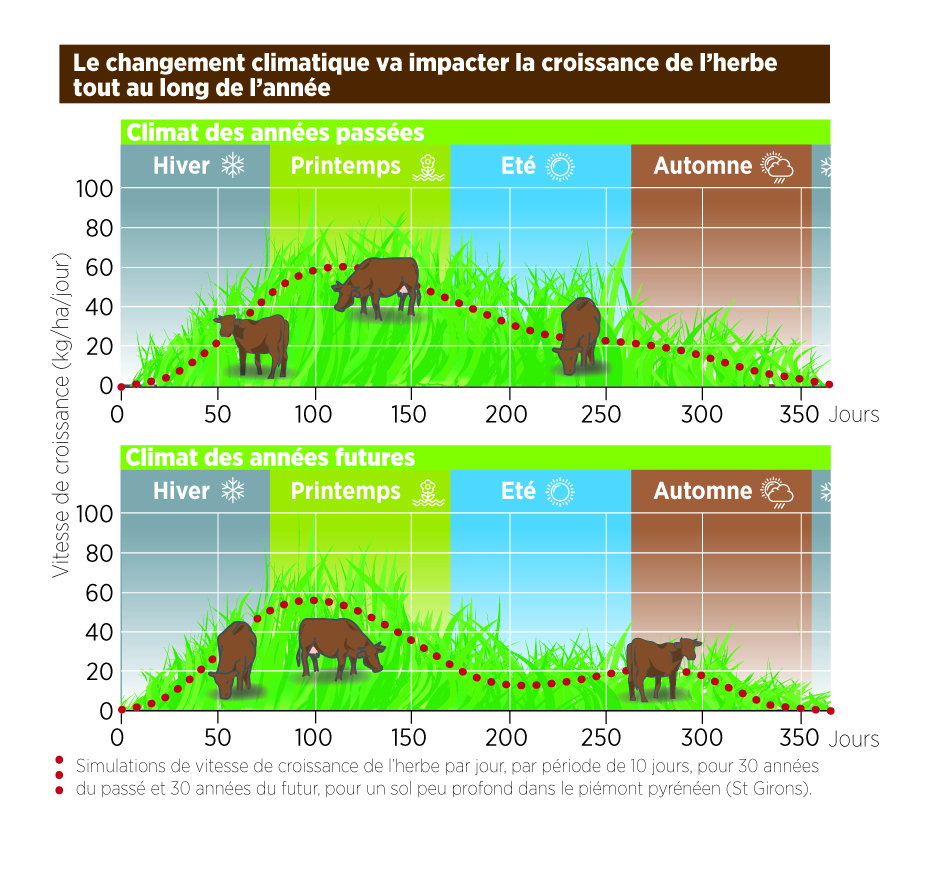Climate change and risks Reading time 3 min
Using virtual experimentation to prepare livestock farmers for climate change adaptation
Published on 11 January 2018
Farmers of cattle, sheep and other ruminants must feed their animals every day. To do so, they use forage crops - grass that is grazed or in silage, maize silage - produced largely on the farm. But what if climate change meant this production could no longer be guaranteed to be as regular in terms of quantity and quality as it was in the past? Farmers will then have to make changes to their systems, so how can we prepare them? There were many questions to which the FARMATCH project - Farming systems adaptation to climate change - wanted to provide answers.
A future with more irregular forage production
“Our first job was to characterise the vulnerability of farms to climate change,” explains agronomist Michel Duru, co-leader of the project. Researchers have simulated the production of forage for animal feed over the next 30 to 50 years using weather predictions from Météo France.
“For grasslands, we showed that while, on average, the quantity of annual grass production would not change, there would be important variations not only within the year but also between years,” adds Michel. “Production in the summer and autumn will decrease while production in the spring will increase. Meanwhile, maize yields will also experience greater year-to-year variability and harvests will be reduced if irrigation is not available.”

Using virtual scenarios
In order to overcome this intra- and inter-annual variability, farmers will have to develop adaptation strategies and introduce short-term or structural changes depending on the current configuration of their system. Numerous options are available. For example, a farmer could change the calving period, shifting it to a period when there is less variability in feed resources, decide to cap milk production below its production potential, sow annual forage crops such as sorghum between two cash crops to cope with an insufficient grass harvest in the spring or change the date the herd is put out to grass etc.
“Based on the principle that to learn, we must experiment, we decided to put livestock farmers into virtual scenarios,” says Roger Martin-Clouaire, a researcher in artificial intelligence and co-leader of the project. Scientists had developed a game as a learning tool in the form of Forage Rummy (1), where livestock farmers are put into a situation where they design their livestock system. In FARMATCH, the climatic context to which they must adapt their system is presented in three sequences so as to progressively approach the conditions in which they operate.
“Over the course of the first two two-hour sequences, farmers are encouraged to appropriate the game and then to design a livestock system adapted to a variety of future climatic years; the consistency being validated by a computer model,” explains the researcher. The first two sessions are conducted with a climate which is presumed to be known in advance. In the third session, the climate is unveiled only month by month. “So, projected virtually into various climate scenarios, livestock farmers test, without consequences, different adaptation options,” concludes Roger.
The diversity of forage resources: an advantage in the face of climate change
“Livestock systems with a wide variety of forage resources, such as grasslands with varied flora and different levels of intensification (multiple use of mixed or maslin(2) crops), are more robust in the face of climate change,” explains Michel Duru. “They mainly require tactical adjustments, such as the proportion of areas to be allocated to pasture, silage or even cereals in the case of maslin crops.”
However, intensive non-irrigated maize systems are more vulnerable to water stress and force farmers to make major changes to their animal feed arrangements. The simulations showed that it was necessary to revise milk performance and/or animal numbers and to diversify resources, for example, by introducing lucerne. This observation was made clear to livestock farmers thanks to the simulations conducted during the project.
(1) Martin, G., Felten, B., Duru, M., 2011a. Forage rummy: A game to support the participatory design of adapted livestock systems. Environ. Model. Softw. 26, 1442–1453.
(2) Mixture of cereals with legumes
References:
- M. Sautier, M. Piquet, M. Duru, R. Martin-Clouaire (2017) Exploring adaptations to climate change with stakeholders: A participatory method to design grassland-based farming systems. Journal of Environmental Management, 193, 541-550.
- M. Sautier, R. Martin-Clouaire, R. Faivre, M. Duru (2013) Assessing climatic exposure of grassland-based livestock systems with seasonal-scale indicators. Climatic Change, 120(1-2), 341–355.
